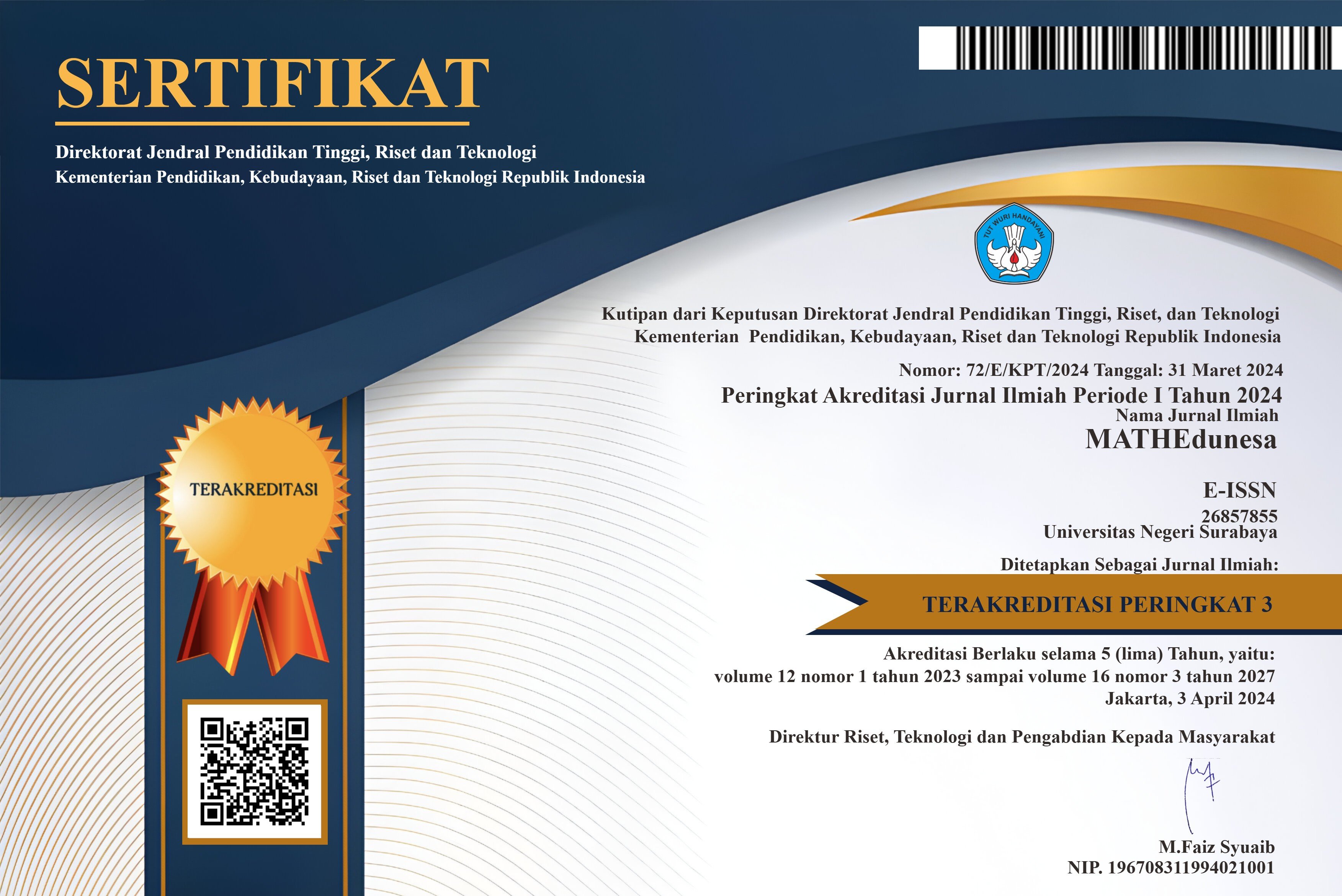PROFIL PEMECAHAN MASALAH PISA PADA KONTEN CHANGE AND RELATIONSHIP SISWA SMP DITINJAU DARI KECERDASAN LINGUISTIK, LOGIS-MATEMATIS, DAN VISUAL-SPASIAL
DOI:
https://doi.org/10.26740/mathedunesa.v6n3.p%25pAbstract
Abstrak
Dalam penerapan kurikulum 2013, siswa perlu diajarkan langkah-langkah pemecahan masalah agar dapat mengembangkan kemampuan membangun ide-ide dan dapat berlatih menerapkan konsep-konsep dan kemampuan yang telah dipelajarinya. PISA dirancang untuk mengetahui apakah siswa dapat menggunakan potensi matematikanya itu dalam kehidupan nyata di masyarakat melalui suatu konsep belajar matematika yang kontekstual. Dalam suatu pemecahan masalah yang kontekstual termasuk soal PISA pada konten change and relationship, tidak semua siswa berpikir tentang ide-ide yang sama untuk menyelesaikan masalah tersebut. Hal ini dipengaruhi oleh berbagai hal, salah satunya adalah kecerdasan. Gardner mengidentifikasikan kecerdasan atas 8 jenis kecerdasan setiap individu, 3 diantaranya adalah kecerdasan Linguistik, Logis-Matematis, dan Visual-Spasial.
Penelitian ini bertujuan untuk mendeskripsikan profil pemecahan masalah PISA siswa SMP ditinjau dari kecerdasan linguistik, logis-matematis, dan visual-spasial. Penelitian ini merupakan penelitian deskriptif kualitatif yang menggunakan metode angket, tes, dan wawancara. Subjek pada penelitian ini terdiri dari 3 siswa dengan jenis kecerdaan berbeda, jenis kelamin sama, dan kemampuan matematika setara. Pemecahan masalah siswa dianalisis berdasarkan langkahpemecahan masalah Krulik dan Rudnick yaitu membaca masalah, mengeksplorasi, memilih strategi, menyelesaikan masalah, dan merefleksi. Langkah pemecahan masalah siswa dimungkinkan kembali ke langkah sebelumnya ketika mengalami kesulitan, sehingga terdapat kedinamisan langkah pemecahan masalah.
Berdasarkan hasil penelitian, semua subjek menunjukkan kedinamisan dalam langkah pemecahan masalah. Subjek Linguistik hanya membaca permasalahan sebanyak dua kali walaupun kalimat pada permasalahan merupakan kalimat yang panjang, mengulangi langkah membaca masalah, mengeksplorasi, dan memilih strategi ketika berada di langkah refleksi. subjek linguistik mengalami kesulitan dengan masalah PISA level 2, 3, dan 5. Subjek Logis-matematis membaca masalah rata-rata empat kali dikarenakan kalimat pada permasalahan merupakan kalimat yang panjang, logis-matematis mengulangi langkah membaca masalah ketika berada pada langkah menyelesaikan masalah. Subjek logis-matematis mengalami kesulitan dengan masalah PISA level 6. Subjek visual-spasial membaca permasalahan rata-rata empat kali, tiga kali saat permasalahan disertai gambar grafik, mengulangi langkah membaca masalah dan memilih strategi ketika berada pada langkah menyelesaikan masalah. Subjek visual-spasial mengalami kesulitan dengan masalah PISA level 3,5, dan 6.
Kata Kunci: Pemecahan Masalah, PISA, Linguistik, Logis-Matematis, Visual-Spasial
Abstract
In applying the 2013 curriculum, students need to be taught the problem-solving steps in order to develop their ability to build ideas and can practice applying the concepts and abilities they have learned. In addition, there is an OECD work program called PISA. PISA is designed to determine whether students can use their mathematical potential in real life in society through a contextual learning concept of mathematics. In a contextual problem solving including PISA on the content of change and relationship, not all students think about the same ideas to solve the problem. It is influenced by many things, one of which is intelligence. Gardner identifies intelligence on 8 types of intelligence per individual, 3 of which are Linguistic, Logical-Mathematical, and Visual-Spatial intelligence.
This research purpose is to describe the profile of PISA’s problem solving of junior high school students based on linguistic, logical-mathematical, and visual-spatial intelligence. This research is a qualitative descriptive research using questionnaire, test, and interview method. Subjects in this research consisted of 3 students with different types of intelligence, same sex, and equivalent mathematical ability. Students problem solving were analyzed based on the Krulik and Rudnick,s problem solving steps which were read the problem, explore, choose strategy, solve the problem, and reflection. Student’s problem solving steps were suspected back to the previous step when students were finding some difficult thing., so there are a dynamical in student’s problem solving.
Based on the results of this research, all subjects showed a dynamical problem solving. Linguistic subjects only read the problem twice though the sentence on the problem is a long sentence. When linguistic subjects in reflection step, she was getting difficult things, so she repeated to the read the problem, explore, and choose the strategy steps. Linguistic subjects was getting difficult with PISA’s problems of level 2, 3, and 5. Logical-mathematical subjects read the problems are about four times because she said that the sentence on the problem was a long sentence. When logical-mathematical subjects in the solve the problem step, she was getting difficult things, so she repeated to the read the problem step. The logical-mathematical subject was getting difficult with the PISA’s problem of level 6. The visual-spatial subject read the problem about four times, three times when the problem is accompanied by a graphic image. When visual-spatial subjects in solve the problem step, she was getting difficult, so she repeated to the read the problem and choose a strategy steps. Visual-spatial subjects was getting difficult with PISA’s problems of level 3.5, and 6.
Keywords: Problem Solving, PISA, Linguistic, Logical-Mathematical, Visual-Spatial
Downloads
Downloads
Published
Issue
Section
 Abstract views: 191
,
Abstract views: 191
, PDF Downloads: 191
PDF Downloads: 191




